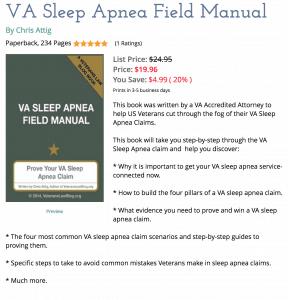Here’s what I think George Carlin would say to the Federal Circuit Court of Appeals in their opinion endorsing a Veteran’s loss of his VA Disability Benefits:
“No need for a double-standard, one standard will do just fine.”
What am I talking about, you ask?
I’ll tell you – this time it has to do with a Veteran losing VA Disability Benefits.
Remember a while back I told you about the Middleton case at the Federal Circuit Court of Appeals?
That’s the case where the Fed Circuit said that if a Veteran’s medical treatment for diabetes in 2014 wasn’t exactly the same as the types of medical treatment that existed in 1986, the Veteran was not entitled to higher levels of compensation.
It’s the one where I argued that the Court’s decision elevated “form over substance” and reached the wrong ruling.
Well, it looks like the Court applied the exact OPPOSITE logic – this time, to the benefit of the VA.
Here’s the Veteran’s story of how he lost his VA Disability Benefits.
You can find the full text of the Court’s opinion in Stallworth here.
While on active duty, Mr. Stallworth was discharged because of psychotic episode.
The record is not clear if that psychotic episode was due to an independent psychosis or if the Veteran’s experimentation with LSD caused it.
In any event, the VA sided with the Veteran, and service-connected him at discharge with 50% impairment rating in October 1975.
2 years later in 1977, a couple of docs at a VA Medical Center decide that the Veteran is “gaming the system” and doesn’t really have a mental health condition.
Interestingly, none of them felt strongly enough about their position to say that the prior diagnosis of a mental health condition was “clearly erroneous”, as 38 CFR 3.105(d) requires.
Never missing an opportunity to take advantage of vagueness in medical opinions, the VBA severed the Veteran’s service connection on the grounds that the mental health diagnosis was in error and mistakenly made (this is different from reducing the rating – severance is really, really rare).
Again – nobody at the VA followed the letter of the law and certified that the prior diagnosis was “clearly erroneous”.
[As an aside – I am not willing to certify under oath – under penalty of perjury – that I have exactly recited the facts of the case in this blog post. Does that give you more or less confidence in my assessment of this case?]
Mr. Stallworth took issue with the decision to sever his VA disability compensation completely. He asked, essentially, if the VA docs weren’t ready to legally certify their conclusions, were they really valid conclusions?
He went out and hired the best of the best – a Veterans’ advocate and attorney Ken Carpenter.
Ken has been helping Vets for 30+ years, and when someone starts bashing attorneys that represent Veterans only to get a fee, I roll out “Ken Carpenter” as Exhibit 1.
He’s the Trident missile of Veterans Benefits Law.
The Seal Team 6 of mental health condition claims and appeals.
Ken has made some serious sacrifice in his life and profession to ensure that Veterans get the best representation available – and he is at it to this day.
Once Mr. Stallworth brought the “big guns” on board, he appealed the severance of service connection – claiming the VA committed Clear and Unmistakeable Error when it severed service connection on the basis of an inadequate C&P exam opinion.
Stallworth’s argument: 38 CFR 3.105(d) expressly requires that a VA doctor certify that a previous diagnosis was clearly erroneous; because the 1977 hospitalization report did not make that formal certification, it was inadequate evidence on which to base a complete severance of service connection.
Here’s what you would THINK might happen in light of the Court’s “logic” in Middleton.
After the Middleton case, it seems like the Court might have agreed with the Veteran who lost his VA Disability Benefits in this case – in Middleton the Court’s decision took a “strict constructionist” approach to a VA regulation and said that the language of the VA regulation was clear on its face and deprived the Court of jurisdiction.
Remember how that worked out?
Badly for the Veteran.
The Court said that where the Impairment Rating regulation requires use of insulin injections to get compensation for service connected diabetes greater than 10%, the regulation is clear and cannot be avoided.
So, even if the Veteran gets an injection of a drug that creates insulin, the exact wording of the regulation is so clear that he is not entitled to compensation higher than 10%.
The Court’s decision in the Stallworth case clearly recognizes the same rule of law that founded the logical cornerstone of their decision in Middleton:
“the plain language of the regulation dictates that service connection may be terminated if a medical professional certifies that his or her review of all accumulated evidence indicates that the prior diagnosis is clearly erroneous.”
So, let’s get our bets on the table….did the Court’s decision in Stallworth reverse the VA’s erroneous severance of service-connection because the VA failed to follow the exact wording of the regulation?
Nope. This time, the Court appears to say that following the exact wording of a regulation “elevates form over substance”:
“Stallworth’s assertion that §3.105d can be satisfied only by recitation of the exact language of the regulation in the medical opinion would elevate form over substance.”
In this cumbersome and myopic bureaucracy that is the VA Claims and Appeals Process, far too many Veterans are forced to accept negative outcomes when the VA is allowed to elevate form over substance (I’m speaking of the administrative process in this sentence, not the court decisions referenced in the post).
The Fed Circuit decision confuses counsel and laymen.
Listen, I can deal with Courts, Judges and Attorneys that make decisions I don’t agree with.
I can deal with Courts, Judges and Attorneys that make what I think are the wrong decision.
I can even deal with Courts getting new Judges who decide to shift the Court’s analysis in a different philosophical direction.
That’s life, and the living nature of the law.
What I have real difficulty with are decision that – to this attorney and to the layman – appear to elevate outcome over logic.
I’m not saying that any Judge engaged in “outcome based reasoning” – I can’t speculate about things I don’t know.
But the appearance of this possibility does as much as anything to tear the fabric of justice: the appearance of outcome based reasoning is one of the big reasons that Veterans have so little trust in the benefits system that is supposed to be helping them.
5 Reasons that “Outcome Based Reasoning” is bad:
Let’s talk about the idea of Outcome Based reasoning, very generally, and not in reference to any specific case:
1) At least one of the parties never knows what to expect when you go before a court – at least until that party figures out which outcome the court prefers.
2) Lower “courts” and administrative tribunals become inefficient boon-doggles – in the case of Veterans Appeals, it can take decades for an issue to trickle up to the Federal Circuit Court of Appeals. In the meantime, nobody knows the law or how to apply it. Lives are destroyed, or ruined, while the matter is resolved.
3) Outcome based reasoning takes the system of “checks-and-balances” that is core to our Constitutional system, and tumps it on its head. Practitioners are left scratching our heads: can the VA ignore the plain wording of Congressional Statutes and Executive regulations? Or are they supposed to strictly adhere to those laws, rules, or regulations? I am reminded of an old vaudeville skit (my improvisation):
Q: Who wins the Case?
A: The VA wins the Case.
Q: Why?
A: Question is Moot. The VA wins the case.
4) Outcome based reasoning takes the concept of precedent based law – the foundation of American Jurisprudence – and eviscerates it.
5) When it comes to outcome based reasoning, the perception becomes reality: judicial outcomes are “influenced” by things outside the courtroom is reinforced. I’m not suggesting any judge is “on the take” — not at all — the problem is PERCEPTIONS.
There is a belief in America – that I feel is reflected in the Veterans community – that justice is based on personal and political agendas – not the facts or the law.
If a court’s lack of consistent logic, reasoning and deduction appears to slant the system so heavily in favor of one party to the litigation, the community of people affected by the “slant” wonder what it takes to get a FAIR decision — money, gifts, future employment, trips, an unlimited supply of the most fashionable powdered wigs?
Again, to be clear, I’m not accusing any specific judge of any misconduct in particular.
What I am saying is that the inconsistent logic in court decisions does not help to eliminate the perception that the Veterans benefits appeal system is a matter of something other than facts, fairness and justice.







Hands down the best thing you have ever written and arguably the very best piece of veteran law analysis on a layman’s level ever done by anyone. You sir are a treasure to your fellow veterans. I salute you, and where ever you lead, I will follow.
Ron, that is about the nicest thing I’ve heard in a while. Thank you.
One thing I’ve always strived to do on this blog is to write in a fashion that takes boring legalese and turns it into information that Veterans can use in their own claims. The law is for all of us – not just the “Powdered Wigs” that too often decide our fate.
Great things on the horizon – please let me know what information I can put out that would be MOST helpful to the MOST Veterans.
Chris
PS…I’m going to reblog your review of “Thank you for your service” shortly…have not forgotten, sir!